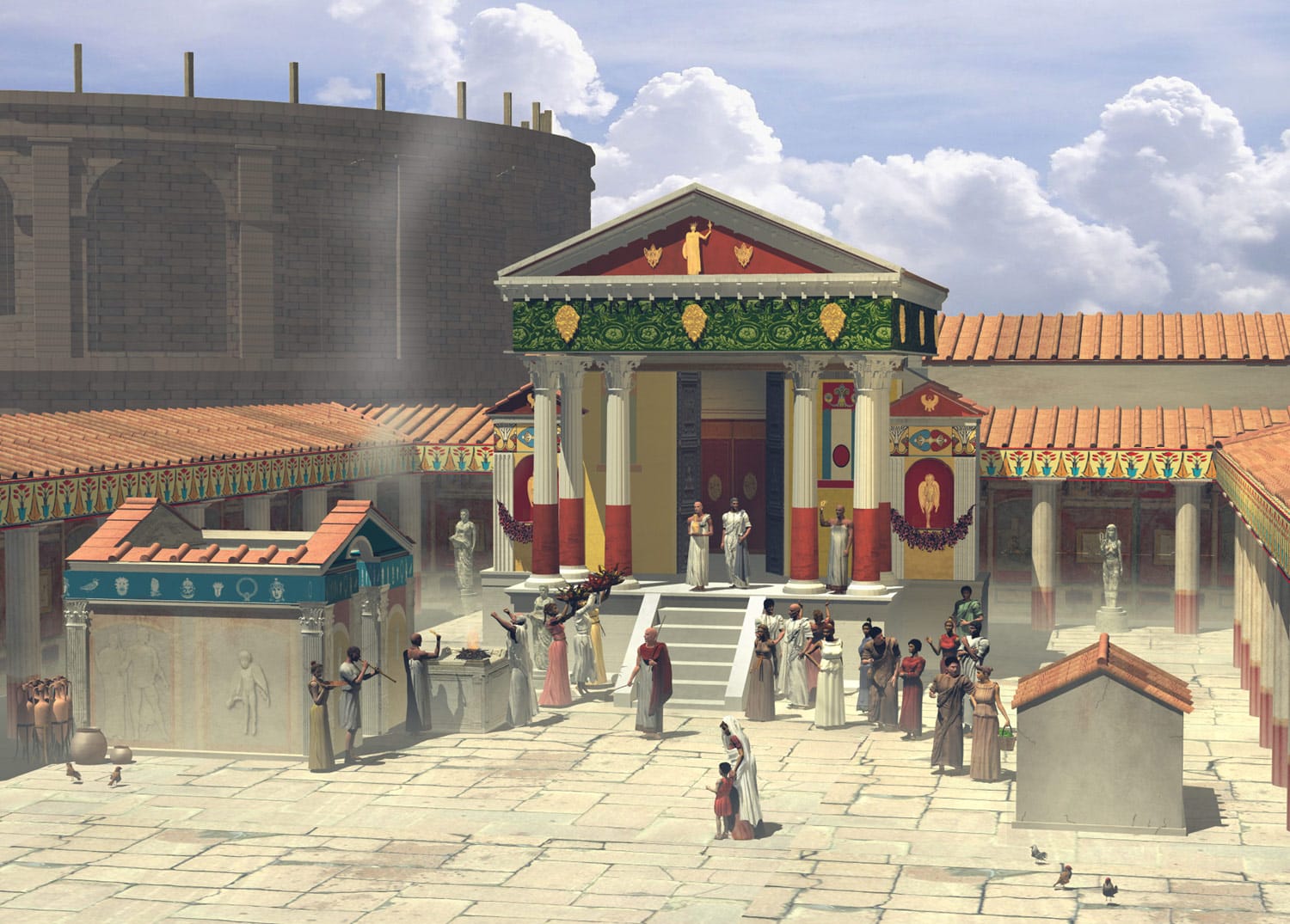Did you know that Pompeii’s most impressive temple wasn’t the one dedicated to Apollo, like most people think? It was actually the enormous Temple of Jupiter, which stood tall at the top of the Forum. This incredible building wasn’t just a place to pray; it was the heart of the city, where people came together for all sorts of important events.
Pompeii’s True Architectural Marvel
You know Pompeii, right? That ancient Roman city frozen in time by a volcanic eruption? Most people have heard about it, and many believe the Temple of Apollo was the biggest deal there. It’s understandable – the Temple of Apollo is pretty impressive. But, there’s another temple, hidden in plain sight, that dwarfs even that: the Temple of Jupiter. This is Pompeii’s biggest temple, and it’s time it got its due.
Imagine yourself standing in the Forum, the bustling heart of Pompeii. All around you, life unfolds: merchants hawk their wares, citizens go about their day, and gossip is exchanged like currency. But then, your gaze is drawn to it – the Temple of Jupiter. This isn’t just a temple; it’s a statement. Perched atop a massive podium, with a grand staircase leading to its entrance, and surrounded by towering columns, it radiates an aura of power and importance. This is Roman architecture at its finest – bold, imposing, and built to inspire awe.
The Temple of Jupiter’s significance goes far beyond its impressive looks. Think of it as the ultimate symbol of Roman power and the might of Jupiter, their king of the gods. While the Temple of Apollo hints at earlier Greek influences, the Temple of Jupiter screams “Rome!” This was probably where the city’s most important documents were kept safe and where Pompeii’s citizens gathered to honor Jupiter with grand festivals and ceremonies. There may have even been a colossal statue of the god himself inside, further emphasizing his dominance.
Sadly, the eruption of Mount Vesuvius in 79 AD put a stop to Pompeii’s vibrant life. The temples, once buzzing with activity, were buried under tons of ash and pumice. But here’s the thing about Pompeii: it’s like a snapshot of the past. When you walk through the ruins of the Temple of Jupiter, you’re not just looking at stones and columns; you’re stepping back in time. You can almost hear the murmur of prayers, feel the weight of history, and sense the presence of the people who once walked its grounds.
If you ever get the chance to visit Pompeii, do yourself a favor: make the Temple of Jupiter a top priority. It’s a powerful reminder of the grandeur of Rome, the mysteries of the past, and the enduring power of human ingenuity.
Delving Deeper: The Significance of Pompeii’s Biggest Temple
Our exploration of Pompeii’s architectural wonders leads us to the most magnificent temple of them all: the Temple of Jupiter. This structure, so grand it towered over all other religious buildings in the city, was impossible to miss. Situated in the bustling heart of Pompeii, the Forum, it served as a constant reminder of Roman might and faith.
The temple’s imposing presence was unmistakable. A massive podium elevated it high above the surrounding buildings, a dramatic staircase led to its entrance, and rows of towering columns emphasized its grandeur. This wasn’t simply a place of worship; it was a symbol of power and authority. Inside, more than just offerings were kept; crucial documents, the kind that held the city together, were likely stored within its sacred walls. And those walls, if they could talk, would tell tales of grand festivals thrown in honor of Jupiter, the king of the gods.
Dominating the temple’s interior may have been a colossal statue of Jupiter himself, serving as a constant reminder of his supreme power and the reverence he commanded from the people of Pompeii.
Though now in ruins, the Temple of Jupiter still stands as a testament to the architectural genius of the Romans. Walking through its remains is like taking a trip back in time, offering a glimpse into the beliefs and daily lives of Pompeii’s citizens. It makes you wonder, what other secrets are yet to be unearthed from beneath the ashes?
Unveiling Ancient Rome’s Largest Temple: The Temple of Venus and Roma
We’ve journeyed through some impressive structures in ancient Rome, but prepare to be amazed by the largest temple of them all: the Temple of Venus and Roma. This building was so grand, so massive, that it would have left any visitor in awe! And the visionary behind this architectural marvel? None other than Emperor Hadrian, a ruler known for his love of all things grand and awe-inspiring. He kicked off this ambitious project in the early 2nd century AD, probably aiming to outdo every other temple in the Roman Empire, making a bold statement about Roman power.
Instead of dedicating the temple to just one deity, Hadrian decided to double the impact. He envisioned two enormous chambers, each housing a colossal statue – one of Venus, the goddess of love and beauty, symbolizing prosperity, and the other of Roma, the goddess personifying Rome itself, representing the empire’s enduring spirit. Imagine walking into this temple, the sheer scale of these statues towering over you. It must have been an awe-inspiring experience.
While we don’t have all the exact measurements, historians and archaeologists are fairly certain, based on existing ruins and historical records, that the Temple of Venus and Roma earned the title of “largest temple in ancient Rome.” To put it in perspective, picture the Pantheon or the Colosseum, both impressive structures in their own right. Now, imagine something even bigger!
Unfortunately, like many ancient structures, this temple has seen its fair share of damage over the centuries. A devastating fire in the 4th century AD left its mark, but even in its ruined state, you can still feel the grandeur, the ambition, the sheer scale of what Hadrian created. These remnants serve as a powerful reminder of the architectural genius of the Roman Empire and the enduring legacy of these two powerful goddesses.
Pompeii’s Sacred Landscape: Exploring the City’s Temples
Stepping back in time to ancient Pompeii, we find a city teeming with life, a place where the sacred and the everyday intertwined. Temples, those grand structures dedicated to the gods, weren’t just places for quiet reflection. They buzzed with activity, serving as centers of religious practice, social gathering spots, and even venues for political affairs. Let’s journey deeper into the heart of Pompeii and uncover the secrets held within the walls of its most notable temples:
The Temple of Jupiter: A Testament to Power
Imagine standing in the bustling forum of Pompeii, your gaze drawn upward to the most imposing structure in the city – the Temple of Jupiter. Dedicated to Jupiter, the king of the gods in Roman mythology, this temple was a bold declaration of Roman might and authority. Inside its hallowed halls probably stood a colossal statue of Jupiter himself, a constant reminder to all who entered of his supreme power. More than just a place of worship, the Temple of Jupiter likely played a pivotal role in the political life of Pompeii, hosting important ceremonies and meetings that shaped the city’s destiny.
The Temple of Apollo: Echoes of Ancient Rhythms
Our journey through Pompeii’s sacred spaces leads us next to the Temple of Apollo, nestled within the bustling forum. This temple, dedicated to Apollo – the god of music, healing, and prophecy – is thought to be one of the oldest in Pompeii, its foundations reaching back to the 6th century BC. Imagine the melodies that must have drifted from its walls, the whispers of oracles sharing glimpses of the future, and the hushed prayers of those seeking Apollo’s healing touch. This temple probably served as a vibrant hub for religious ceremonies, artistic performances, and perhaps even discussions about the affairs of the city.
The Temple of Isis: A Glimpse into a Wider World
Venturing further, we encounter the Temple of Isis, a testament to the cosmopolitan nature of Pompeii and the reach of Roman influence. Dedicated to the Egyptian goddess Isis, this temple provides us with a captivating glimpse into the diverse tapestry of beliefs that coexisted within the Roman Empire. The well-preserved murals and statues inside the temple whisper tales of the Isis cult, a religious tradition that found a welcoming home among the people of Pompeii. The architecture itself reflects this cultural fusion, blending Egyptian and Roman styles in a harmonious union.
As we conclude our exploration of Pompeii’s sacred spaces, let’s remember that our understanding of these temples continues to evolve. Archaeological research constantly unearths new clues, challenging our assumptions and painting a richer, more nuanced picture of life in this ancient Roman city. What we know for sure is that these temples were more than just stone and mortar; they were the beating heart of Pompeii, places where people sought connection with the divine, with their community, and with the wider world around them.
Delve into the depths of ancient Egypt’s history and symbolism with our captivating exploration of scarab, papyrus, and ankh, revealing the vibrant tales of this enigmatic civilization.
Key Points about Pompeii’s Temples
- The Temple of Jupiter is Pompeii’s largest temple, surpassing the Temple of Apollo in size and grandeur.
- Situated on a prominent podium in the city’s Forum, the Temple of Jupiter boasts an imposing staircase and towering columns.
- As a symbol of Roman power, the temple likely housed important documents and hosted grand festivals honoring Jupiter.
- A colossal statue of Jupiter may have dominated the temple’s interior, symbolizing his authority.
- Preserved in Pompeii’s ruins, the Temple of Jupiter offers a glimpse into the grandeur of ancient Rome and the lives of its citizens.
- Visiting the temple is a testament to the enduring power of human architecture and the mysteries of the past.
- Pompeii was home to a variety of temples, showcasing the city’s diverse religious landscape, including the Temple of Apollo and the Temple of Isis.
- Crypto Quotes’ Red Flags: Avoid Costly Mistakes - June 30, 2025
- Unlock Inspirational Crypto Quotes: Future Predictions - June 30, 2025
- Famous Bitcoin Quotes: A Deep Dive into Crypto’s History - June 30, 2025

















1 thought on “Unveiling Pompeii’s Biggest Temple: The Majestic Temple of Jupiter”
Comments are closed.